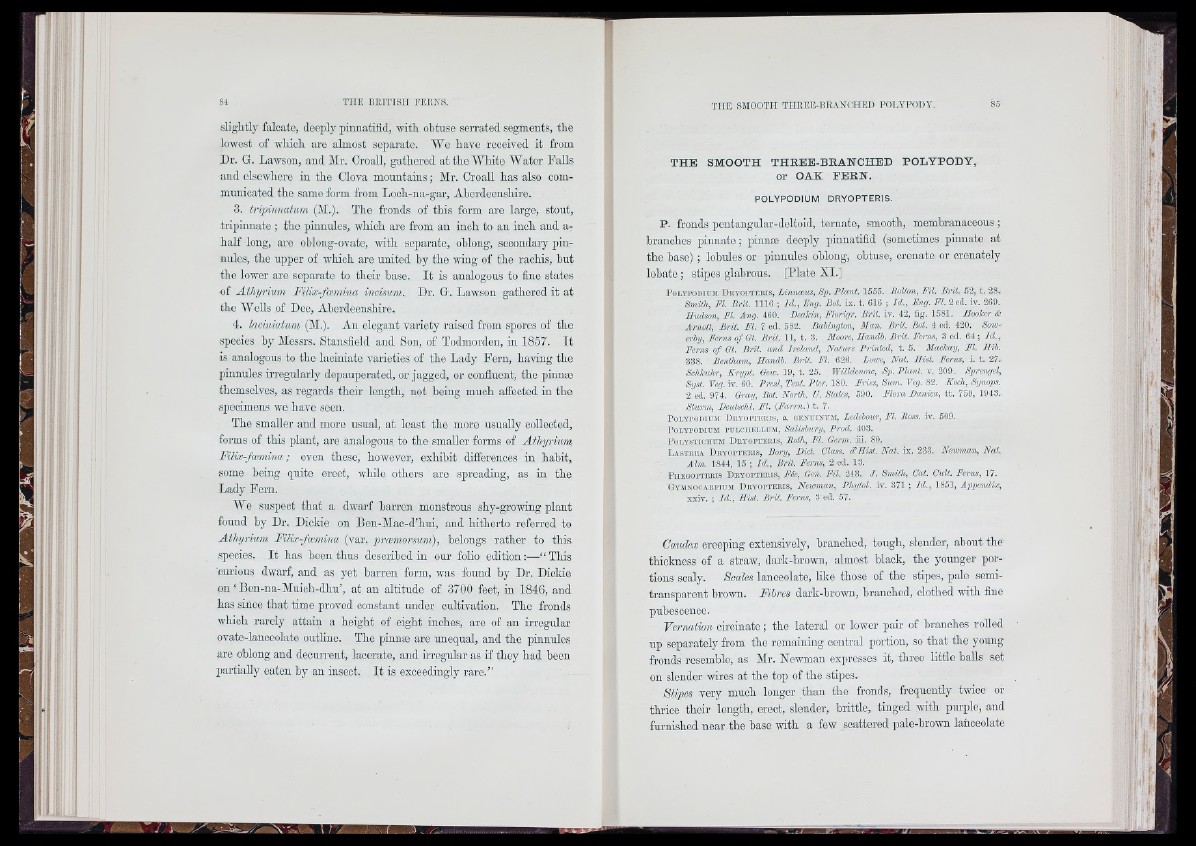
S i -
slightly falcate, deeply pinnatifid, with obtuse serrated segments, the
lowest of which aro almost separate. Wo have received it from
Dr. G. Lawson, and Mr. Croall, gathered at the White Water Falls
and clsowhoro in tho Clova mountains ; Mr. Croall has also oom-
muuioated tho samo form from Looh-na-gar, Aberdeenshire.
3. tripinnatum (M.). Tho fronds of this form aro largo, stout,
tripinnate ; the pinnules, which arc from an inch to an inch and a-
half long, aro oblong-ovate, Avitb separate, oblong, secondary pinnules,
tlio upper of which are united by tho iving of the rachis, hut
the lower are separate to their base. I t is analogous to fine states
of Athyrium Filix-foemina inoisum. Dr. G. Lawsou gathered it at
tho Wells of Doe, Ahordeenshiro.
4. laciniatum (M.). An elegant variety raised from spores of the
species by Messrs. Stansfiold and Son, of Todmorden, in 1857. I t
is analogous to tho laoiniate varieties of tho Lady Fern, having the
pinnules irregularly depauperated, or jagged, or confluent, the pinnæ
themselves, as regards thoir length, not being much affected in the
specimens ive have soon.
Tho smaller and more usual, at least the moro usually collected,
forms of this plant, are analogous to the smaller forms of Athyrium
Filix-foemina; ovon these, however, exhibit differences in habit,
some being quite erect, while others aro spreading, as in the
Lady Fern.
We suspect that a dwarf barren monstrous shy-growiug plant
found by Dr. Dickie on Bcn-Mac-d’hui, and hitherto referred to
Athyrium Filix-foemina (var. præmorsum), belongs rather to this
species. I t has been tbus described in our foHo edition :—“ This
curious dwarf, and as yet barren form, was found by Dr. Dickie
on ‘Bon-na-Muicb-dhu’, at an altitude of 3700 feet, in 1846, and
has since that time proved constant under cultivation. Tho fronds
which rarely attain a height of eight inches, are of an irregular
ovate-lanceolate outline. Tho pinnæ are unequal, and the pinnules
are oblong and decurrent, lacerate, and irregular as if they had been
partially eaten by an insect. I t is exceedingly rare.”
THE SMOOTH THREE-BRANCHED ROLYPODY,
or OAK PERN.
POLYPODIUM DRYOPTERIS.
P. fronds pentangular-deltoid, tomato, smooth, membranaceous ;
branches pinnate ; pinnæ deeply pinnatifid (sometimes pinnate at
the base) ; lobules or pinnules oblong, obtuse, crenate or crcnately
lobato ; stipes glabrous. [Plate XI.]
P o L Y P O m u u D iiY O iuE R is, Limucus, Sp. Plant. 1555. Bolton, Fil. Brit. 52, t . 28.
Smith, FI. Brit. 1116 ; Id ., Fug. Bot. ix . t . 616 ; Id ., Eng. P l . 2 e i . iv. 269.
Hudson, FI. Aug. 460. Deakin, Florigr. Brit. iv. 42, fig. 1581. Hooker &
Arnott, Brit. PI. 7 cd . 582. Babington, Man. Brit. Bot. 4 e d . 420. Som-
erby, Fenis o f Gt. Brit. 11, t . 3. Moore, Handb. B r i t Ferns, 3 cd . 64 ; Id .,
Ferns o f Gt. B r i t ami Ireland, Nature Printed, t . 5. Maekay, FI. Hib.
338. Bentham, Handb. Brit. PI. 626. Lowe, N a t Hist. Ferns, i. t . 27.
Sehlmhr, K r y p t Oew. 19, t . 25. Willdenow, Sp. P la n t v. 2 09. Sjmngel,
SysL Veg. iv. 60. Presl, T en t Pter. 180. Fries, Sum. Veg. 82. Koch, Synoios.
2 c d . 974. Gray, Bot. North. V. States, 690. Flora Danica, t t . 759, 1943.
Sturm, Deutschl. FI, {Fa rm.) t . 7.
POLYPODIUM D r y o p t e r i s , a. g e k u i n u m , Ledebour, FI. Moss. iv. 509.
P o ly p o d i u m p u l c i i e l l u m , Salisbury, Prod. 403.
I ’OLYSTICHUM D ey o p t er is , Moth, PI. Germ. iii. 80.
L a s t r e a D r y o p t e r i s , Bory, Diet Class. T J Iis t N a t ix . 233. Newman, Nat.
Aim. 1844, 15 ; Id ., B r i t Ferns, 2 c d . 13.
P heg opt er is D r y o p t e r i.s, Fée, Gen. Fil. 243. J. Smith, Cat. Cult. Ferns, 17.
Gymno oa epium D r y o pte r is , Newman, Phytol. iv. 371 ; Id ., 1851, Appendix,
x x iv . ; I d ., H is t B r i t Ferns, 3 c d . 57.
Caudex creeping extensively, branched, tough, slender, about the
thickness of a straw, dark-brown, almost black, the younger portions
scaly. Scales lanceolate, like those of tho stipes, pale semitransparent
brown. Fibres dark-brown, branched, clothed with fine
pubescence.
Vernation circinate; tho lateral or lower pair of branches rolled
up separately from the remaining central portion, so that the young
fronds resemble, as Mr. XoAvman expresses it, threo littlo halls set
on slender wires at the top of tho stipes.
Stipes very much longer than tho fronds, frequently twice or
thrice their length, erect, slender, brittle, tinged with purple, and
furnished near the base with a few scattered pale-brown lanceolate
■ 'ii
1 .
j i t